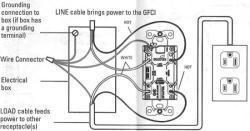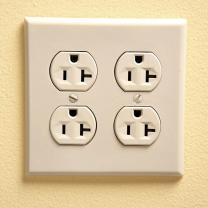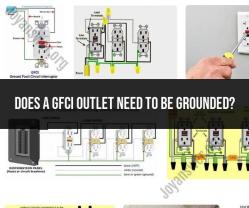Where should GFCI outlets be installed?
Ground Fault Circuit Interrupter (GFCI) outlets are a critical safety feature in electrical systems. They are designed to protect people from electrical shocks and are required by electrical codes in specific locations where there is a higher risk of electrical hazards. Here are common locations where GFCI outlets should be installed:
Bathrooms: GFCI outlets should be installed in all bathrooms, including master bathrooms, guest bathrooms, and powder rooms. Any electrical outlet within 6 feet of a water source, such as a sink or bathtub, should be GFCI-protected.
Kitchens: GFCI outlets should be installed in kitchens to protect against electrical shocks that can occur when using appliances near water sources like sinks. All countertop outlets and those within 6 feet of sinks or wet areas should be GFCI-protected.
Outdoor Areas: All outdoor outlets, including those on decks, patios, porches, and around pools or hot tubs, should be GFCI-protected. This is because outdoor environments are more likely to be exposed to moisture and rain, increasing the risk of electrical hazards.
Garages and Workshops: GFCI outlets are recommended in garages and workshops because these areas often contain power tools and equipment that can be exposed to moisture or used in wet conditions.
Crawlspaces and Basements: If you have outlets in crawlspaces or unfinished basements, it's a good idea to have GFCI protection due to the potential for damp conditions.
Laundry Rooms: GFCI outlets are typically required in laundry rooms, especially near the washing machine and utility sinks, to prevent electrical hazards when water is present.
Wet Bars: If you have a wet bar in your home with a sink, GFCI outlets should be installed near the sink area to ensure safety.
Boathouses and Dock Areas: If you have electrical outlets near a boathouse, dock, or other water-related structures, they should be GFCI-protected to reduce the risk of electrical accidents in wet environments.
Utility Sinks: GFCI outlets are often installed near utility sinks in utility rooms, mudrooms, or other areas where these sinks are used.
Circuit Extensions: When extending electrical circuits or adding new outlets in any location, it's a good practice to use GFCI outlets as they provide an extra layer of protection.
Remember that GFCI outlets should be installed by a licensed electrician to ensure they are correctly wired and functioning as intended. Regular testing of GFCI outlets is also recommended to ensure they are providing the necessary protection. If a GFCI outlet trips repeatedly, it should be inspected and repaired by a qualified professional.
GFCI Outlet Placement: Where to Install for Electrical Safety
GFCI outlets, or ground fault circuit interrupter outlets, are a special type of outlet that can help to protect you from electrical shock. GFCI outlets are required in all wet or damp locations, such as kitchens, bathrooms, laundry rooms, and outdoor areas.
Here are some specific locations where you should install GFCI outlets:
- Within 6 feet of a kitchen sink or countertop
- Within 6 feet of a bathroom sink or bathtub
- Within 6 feet of a laundry room sink or washing machine
- Near outdoor outlets
- In unfinished basements and crawl spaces
- In garages and workshops
Mapping Electrical Safety: Ideal Locations for GFCI Outlet Installation
To map out the ideal locations for GFCI outlet installation, start by identifying all of the wet or damp locations in your home. Then, make a list of all of the appliances and electronics that will be plugged into outlets in those locations.
Once you have a list of all of the appliances and electronics, you can start to map out the best places to install GFCI outlets. For example, you will want to install a GFCI outlet near the kitchen sink so that you can plug in your electric kettle or toaster. You will also want to install GFCI outlets near the bathroom sink and bathtub so that you can plug in your hair dryer or electric toothbrush.
Protecting Your Home: Guidelines for GFCI Outlet Placement
Here are some additional guidelines for GFCI outlet placement:
- Install GFCI outlets in a location that is easy to access. You should be able to reach the outlet quickly and easily in the event of an emergency.
- Do not install GFCI outlets behind appliances or furniture. This will make it difficult to access the outlet if needed.
- Test your GFCI outlets regularly to make sure that they are working properly. You can do this by pressing the test button on the outlet. If the outlet trips, it is working properly.
GFCI outlets are an important safety feature for any home. By installing GFCI outlets in the right places, you can help to protect yourself and your family from electrical shock.
Please note that if you are not comfortable installing GFCI outlets yourself, you should contact a qualified electrician to do it for you.











